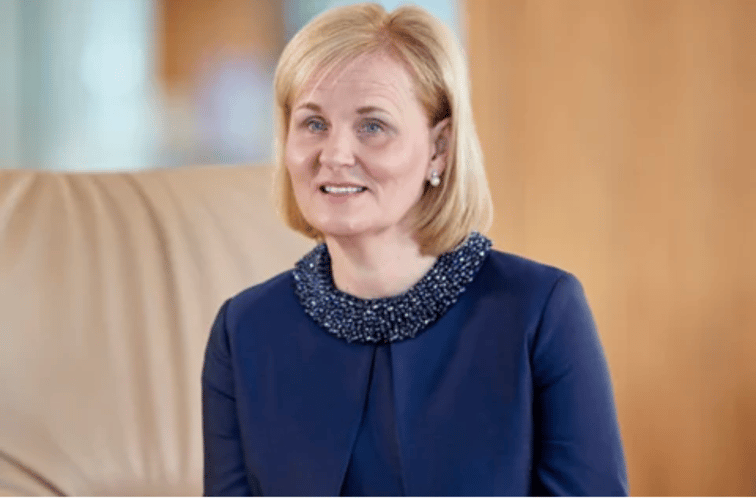

In a media briefing discussing Aviva H1 2022’s trading statement, group CEO Amanda Blanc (pictured) credited the “excellent” results as a testament to the progress the UK insurance giant has made over the past two years in simplifying the business and building its resilience.
Read more: Aviva reports first-half operating results
“Aviva is growing and growing profitably,” she said. “The value of new business in the UK and Ireland life company is up 13% and gross written premiums in the general insurance business are up 6%. Profitability is improving and our operating profit is up 14%, significantly ahead of consensus. We’ve delivered an excellent overall combined operating ratio of 94% despite the impact of inflation, demonstrating the scale and diversification of our general insurance business.”
Blanc noted that Aviva’s interim results were proof that its diversified business and market-leading positions were real advantages in allowing the group to withstand economic pressures and continue to grow. Aviva is growing across insurance, wealth and retirement alike, she said, with the group seeing the commercial arm of its insurance business achieve double-digit growth and display discipline in personal lines.
Aviva’s interim dividend of 10.3 pence per share is in line with its full-year guidance, she said, and reflected its confidence in the strength of the business and underlying cash flow. Beyond its ordinary dividend, Aviva also has scope for additional capital returns. So, surplus capital above its target level of 180% is available for investment in the business and tactical bolt-on M&A to drive further growth.
“The bar for investment and bolt-on M&A is, as I’ve always said, high,” she said. “But we will move if we identify the right opportunity, as we did with the recent acquisitions of Succession Wealth and Azure’s high-net-worth business. But where we can’t achieve sufficient value through reinvesting in the business or M&A, surplus capital will be returned to shareholders over time.”
Blanc announced that Aviva is anticipating returning further capital to its shareholders following the year end via a new share buyback programme, which will be subject to market conditions and regulatory approval.
Looking at Aviva’s strategic priorities, she highlighted that the team has been busy delivering the plan set out in March of this year to transform the group’s performance. The insurer has made over 100 improvements to its MyAviva and Aviva Connect portals, she said, and had half a million new MyAviva registrations in the last 12 months. This is particularly good news as these customers are twice as likely to buy a second policy from Aviva.
“We’ve demonstrated the growth within the business but we can’t rely purely on existing revenue streams,” she said. “So we’re actively exploring new growth opportunities, such as the extension of our partnership with TSB to offer home and travel insurance to TSB’s five million customers, and Aviva Zero, our new green motor insurance product, has now sold over 10,000 policies.
“We’re supporting customers, communities and colleagues as the UK wrestles with financial inclusion and the worst cost-of-living crisis in decades. We’ve committed £15 million to community investment to provide advice and support to vulnerable people and businesses. We continue to make it easier for customers to protect themselves by providing affordable products and extending premium deferral. And we’re supporting 7,000 of our colleagues with a one-off payment to help them with rising energy costs.”
On the subject of the economic turmoil facing many customers, Blanc outlined the knock-on effect that the inflationary environment is having across the market and how it’s impacting customer appetites. In both the UK and Canada, she said, price increases now stand at around 12-to-12.5%. Aviva is seeing inflation of between 8% and 12% depending on which part of the market is being considered.
“So obviously, we priced ahead of inflation,” she said. “Inflation was not a surprise and, back in November last year, we were starting to prepare for that. So I think we’re in good shape as far as that is concerned. Clearly though, if the situation worsens, we will look to put more pricing into the motor and the home product lines.
“In commercial lines, pricing is largely helped by the fact that the commercial lines policies are indexed. So effectively they are indexed for inflation and already take into account the inflation number. And we are very well-balanced between personal lines and commercial lines, and our commercial line business is very profitable.”
In terms of market appetite, Blanc noted that Aviva has seen its retention levels across both its motor and home products remain very strong – with motor standing at between 7% and 8%, and home at a similar level. The strength of the Aviva brand and its service delivery means the insurer is in very good shape to deal with the difficult conditions, she said, and support customers through this challenging period.
“To conclude,” she said, “it has been a very strong start to the year. But we’re not naïve, we know it’s tough out there. We do though, have excellent momentum, and the benefits of our scale and diversified portfolio give us confidence we can continue to deliver for the remainder of the year and beyond. We do what we said we would do one quarter and one customer at a time.”
